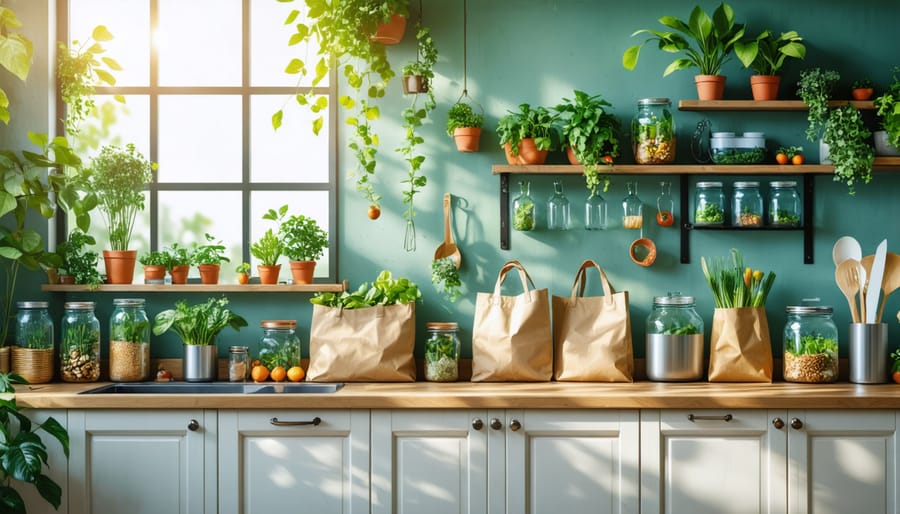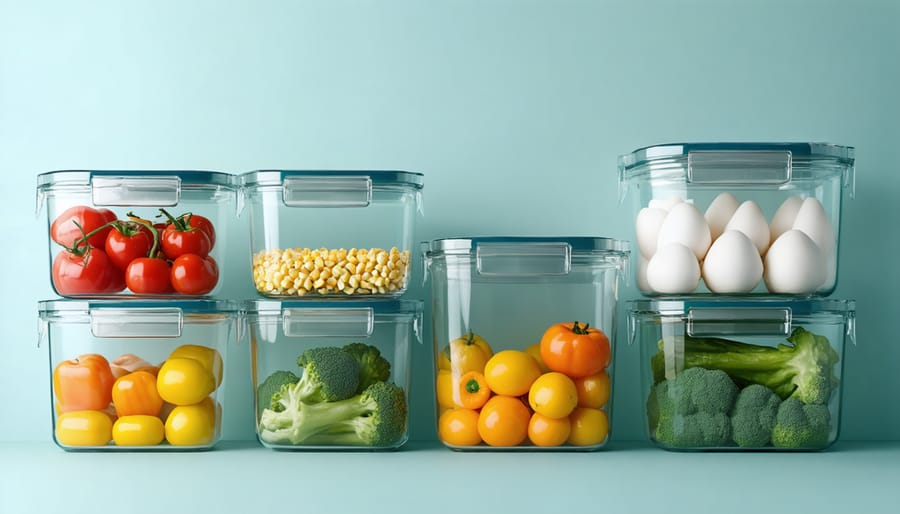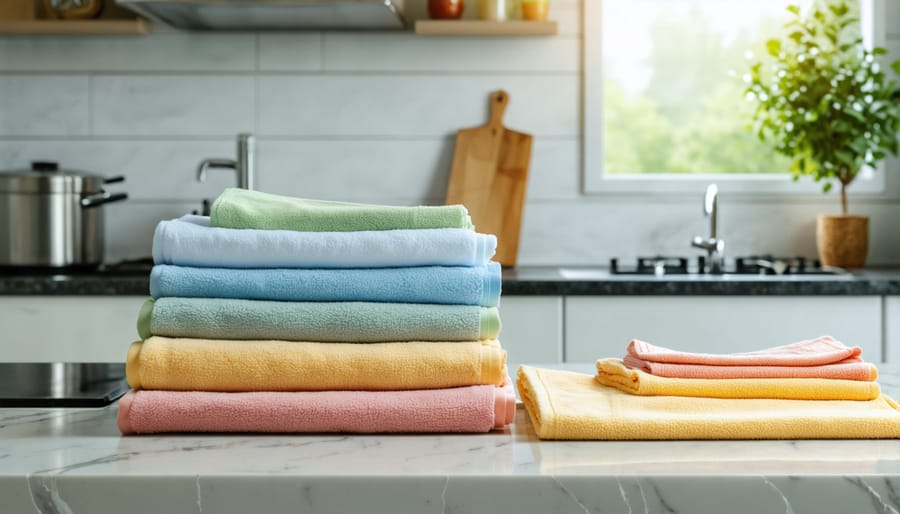
Swap disposable packaged foods for fresh, local produce to reduce plastic waste. Ditch single-use paper towels for reusable cloths and minimize food waste by composting. Replace energy-guzzling appliances with eco-friendly habits like an efficient refrigerator, induction cooktop, and convection oven. Choose natural cleaning products or make your own non-toxic solutions using pantry staples like vinegar and baking soda.
Switch to Reusable Shopping Bags
Ditching single-use plastic bags in favor of reusable shopping bags is a simple yet impactful way to make your kitchen more eco-friendly. Did you know that the average American family takes home almost 1,500 plastic shopping bags a year? That’s a staggering amount of waste, considering that plastic bags can take hundreds of years to decompose in landfills and often end up polluting our oceans and harming wildlife.
By switching to reusable shopping bags, you can significantly reduce your environmental footprint. Reusable bags, made from materials like cloth, canvas, or durable recycled plastics, are designed to be used countless times, eliminating the need for disposable plastic bags. Not only do they help reduce waste, but they’re also sturdier and more convenient for carrying your groceries.
To make the most of your reusable bags, keep a few in your car or by your front door so you always have them handy when heading out to shop. Many stores even offer discounts for customers who bring their own bags, giving you an extra incentive to embrace this eco-friendly habit. By making the switch to reusable shopping bags, you’ll be taking a small but meaningful step towards a greener kitchen and a healthier planet.

Ditch Single-Use Plastic Containers
Are you tired of throwing away countless plastic containers that end up in landfills or oceans? It’s time to ditch single-use plastic and embrace eco-friendly alternatives for your food storage needs. Glass containers are a classic choice, offering durability and versatility. They’re perfect for storing leftovers, packing lunches, and even freezing meals for later. Plus, glass is easy to clean and doesn’t retain flavors or odors like plastic does.
Stainless steel containers are another great option, especially for those on the go. They’re lightweight, unbreakable, and keep your food fresh for hours. Silicone bags and wraps are also gaining popularity as a reusable alternative to plastic wrap and bags. They’re flexible, seal tightly, and can be used for everything from sandwiches to snacks.
By switching to these eco-friendly options, you’ll not only reduce your environmental impact but also save money in the long run. No more constantly buying and tossing plastic containers! And let’s be honest, glass and stainless steel just look so much more stylish in your fridge and pantry. So next time you’re ready to store your leftovers or pack a lunch, reach for these sustainable choices and feel good about your contribution to a greener planet.

Embrace Cloth Napkins and Towels
Swapping out disposable paper napkins and towels for reusable cloth alternatives is a simple yet effective way to reduce waste in your eco-friendly kitchen. Not only do cloth napkins and towels add a touch of elegance to your dining experience, but they also significantly cut down on the amount of paper waste your household generates. Imagine the number of paper napkins and towels you use in a week, a month, or even a year – that’s a lot of trees saved by making the switch! Cloth napkins and towels are durable, long-lasting, and can be easily washed and reused countless times. Plus, with a variety of colors, patterns, and fabrics available, you can find options that perfectly match your kitchen’s style. By embracing cloth napkins and towels, you’re not only reducing your environmental impact but also creating a more inviting and sustainable dining atmosphere for your family and guests. So, next time you set the table or reach for a towel to dry your hands, remember that choosing cloth over disposable paper products is a small change that can make a big difference for the planet.

Invest in High-Quality, Long-Lasting Cookware
Investing in high-quality, long-lasting cookware is not only a smart choice for your wallet but also for the environment. While it may be tempting to opt for cheaper, disposable options, these products often end up in landfills after a short period of use. By choosing durable, well-crafted pots, pans, and baking dishes, you can reduce waste and save money in the long run.
Look for cookware made from materials like stainless steel, cast iron, or ceramic, which are built to withstand years of daily use. These materials are also non-toxic and safe for cooking, ensuring that your food remains healthy and delicious. Although the initial investment may be higher, you’ll save money by not having to replace your cookware as frequently.
When shopping for new cookware, consider versatile pieces that can be used for multiple purposes, such as a Dutch oven or a deep skillet. This will help you minimize clutter in your kitchen and make the most of your investment. Additionally, proper care and maintenance can extend the life of your cookware even further. Decorating on a Budget is possible when you invest in timeless, high-quality pieces that will serve you well for years to come.
By choosing long-lasting, eco-friendly cookware, you’ll not only be making a positive impact on the environment but also ensuring that your kitchen is equipped with reliable tools to help you create delicious, healthy meals for your loved ones.
Choose Energy-Efficient Appliances
When it comes to creating an eco-friendly kitchen, one of the most impactful changes you can make is choosing energy-efficient appliances. While it may seem like a significant investment upfront, these appliances can help reduce your carbon footprint and save you money on utility bills in the long run.
Look for appliances with the Energy Star label, which indicates they meet strict energy efficiency guidelines set by the U.S. Environmental Protection Agency. For example, an Energy Star certified refrigerator uses about 15% less energy than non-certified models, while an Energy Star dishwasher can save you both water and electricity.
When shopping for new appliances, consider their size and features. A larger refrigerator or oven will typically use more energy than a smaller one, so choose a size that fits your needs without being excessive. Additionally, look for features like LED lighting, induction cooktops, and convection ovens, which can further increase energy efficiency.
Don’t forget about smaller appliances, too! Opting for an electric kettle instead of boiling water on the stove, or using a slow cooker or pressure cooker instead of the oven, can also help reduce your energy consumption in the kitchen.
Making the switch to energy-efficient appliances is a win-win situation – you’ll be doing your part to help the environment while also saving money on your energy bills over time.
Opt for Eco-Friendly Cleaning Products
Choosing eco-friendly cleaning products is a simple yet impactful way to make your kitchen more sustainable. Instead of harsh chemicals that can harm the environment and your health, opt for natural, non-toxic alternatives. Many brands now offer plant-based, biodegradable cleaners that effectively tackle grease and grime without the negative side effects. You can also create your own cleaning solutions using ingredients like vinegar, baking soda, and essential oils. These natural cleaning products are not only better for the planet but can also save you money in the long run. Plus, you’ll have peace of mind knowing that your kitchen surfaces are safe for food preparation and free from harmful residues. By making the switch to eco-friendly cleaners, you’re taking a proactive step towards reducing your environmental footprint and creating a healthier home for yourself and your loved ones. So next time you’re stocking up on cleaning supplies, consider the green alternatives and feel good about keeping your kitchen sparkling clean and sustainably minded.
Reduce Food Waste with Meal Planning
Meal planning is a simple yet effective way to reduce food waste in your eco-friendly kitchen. By taking a few minutes each week to plan your meals, you can ensure that you only buy what you need and use up ingredients before they spoil. When planning, consider recipes that utilize similar components so you can streamline your shopping list and cooking process.
Proper food storage is another key aspect of minimizing waste. Invest in quality, airtight containers to keep your ingredients fresh for longer. Label and date your leftovers so you can easily track what needs to be consumed first. If you find yourself with extra produce, consider freezing, canning, or dehydrating them for later use. Learn more about how to store items like coffee beans properly to preserve their flavors and reduce waste.
Getting creative with leftovers is not only a great way to reduce waste but also an opportunity to try new flavor combinations. Transform last night’s roasted vegetables into a hearty frittata or blend them into a nourishing soup. Repurpose stale bread into croutons or breadcrumbs for added texture in salads and casseroles.
By adopting these eco-friendly habits, you’ll not only minimize your kitchen’s environmental impact but also save money and enjoy more mindful, sustainable eating practices. With a little planning and creativity, you can make the most of your ingredients while reducing your carbon footprint, one meal at a time.
Making your kitchen more eco-friendly is a journey, but every small change adds up to a significant impact. By implementing these simple swaps and adjustments, you’ll be well on your way to creating a more sustainable kitchen that benefits both your family and the planet. Remember, progress is more important than perfection. Start with one or two changes that feel manageable for you, and gradually incorporate more as they become habits. As you embrace this eco-friendly lifestyle, you’ll not only reduce your environmental footprint but also discover a sense of satisfaction and purpose in your daily kitchen routines. So, get started today and enjoy the process of creating a greener, more mindful kitchen space that you can feel good about.



